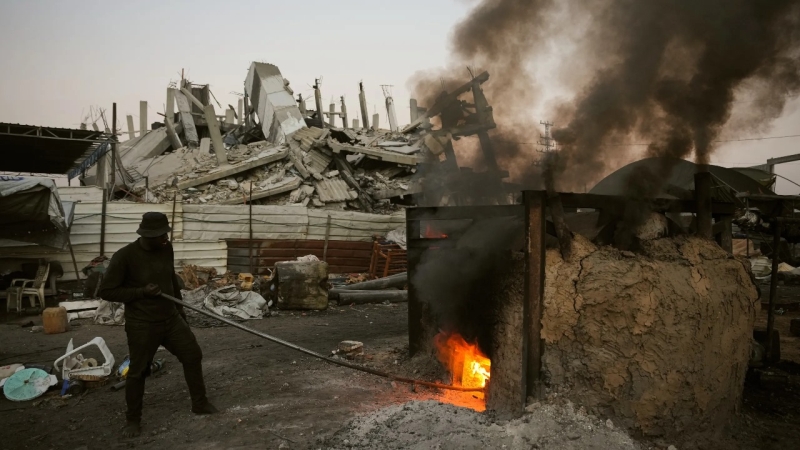- Bangladesh earthquake death toll rises to 10; scores injured |
- CA for Armed Forces' efficient role to ensure smooth, festive polls |
- Tarique Rahman calls for urgent disaster preparedness after quake |
- UN Unveils UN80 Action Plan to Drive System-Wide Reforms |
- Guterres Urges G20 to Show Leadership and Vision in SA |
Israeli Strikes Kill 33 in Gaza as Fragile Ceasefire Frays

Khalil Al-athamnah 25 prepares a makeshift burner used to extract fuel from melted plastic in Zawaida, central Gaza strip, Thursday, Nov. 20, 2025.
Israeli airstrikes on the southern Gaza city of Khan Younis have killed five people, hospital officials said, raising the death toll to 33 in roughly 12 hours. Most of the victims were women and children, making these among the deadliest incidents since the U.S.-mediated ceasefire took effect on 10 October.
Israel said the strikes came in response to gunfire directed at its forces in Khan Younis on Wednesday. No Israeli soldiers were killed.
Four strikes on tents sheltering displaced Palestinians in Khan Younis between Wednesday night and Thursday morning killed 17 people, including five children and five women, according to Nasser Hospital.
In Gaza City, two airstrikes destroyed a building and killed 16 people—among them seven children and three women—Al-Shifa Hospital reported.
Hamas condemned the attacks as a “horrific massacre” and denied firing at Israeli troops.
Grief Across Gaza
At Nasser Hospital, large crowds gathered to perform funeral prayers. Women wailed over bodies wrapped in white shrouds.
Abir Abu Moustapha lost her three children—aged one, eleven and twelve—and her husband when their tent was hit. She knelt beside their bodies as they were prepared for burial.
“My children are gone. What can I say? And my husband, the dearest to me. May God have mercy on them,” she said. “What did my children do? Why did they have to die before my eyes?”
The Israeli military said the attacks targeted two Hamas members: a naval forces commander and another official responsible for tunnel operations in the Khan Younis area.
Ceasefire Under Strain
Hospital officials said the dead came from both sides of the division created by last month’s ceasefire, which split Gaza and placed about half the territory under military control.
The escalation followed the UN Security Council’s endorsement of a U.S. proposal outlining new governance and security arrangements for Gaza, including an international security force and a transitional administration. Hamas rejected the plan, arguing that disarmament requirements compromise the force’s neutrality and favour Israel.
Although strikes have decreased since the ceasefire began, they have not ceased entirely. Gaza’s Health Ministry—whose figures are widely considered credible by the UN—reports more than 300 deaths since the truce started.
Israel’s military campaign has killed more than 69,000 Palestinians since it began over two years ago in response to Hamas’ 7 October 2023 assault on southern Israel, which left around 1,200 people dead and 251 taken hostage.
Under the 10 October ceasefire terms, Hamas released the remaining 20 living hostages in exchange for hundreds of Palestinian detainees. It has also returned the bodies of 25 deceased hostages and is expected to hand over three more.
Abuse Allegations from Hostages and Detainees
A recently released Israeli hostage, Guy Gilboa-Dalal, has alleged that he was sexually assaulted by a Hamas captor during his detention. He said he was threatened with a rifle and knife and warned not to speak about the incident. His full interview is expected to air on Saturday. Hamas has not responded to the allegation.
Another former hostage, Rom Braslavski, has also reported sexual abuse.
Meanwhile, Palestinians freed from Israeli prisons after being detained during the war have described being stripped to their underwear, beaten, subjected to sexual abuse, restrained for days, and denied adequate food and medical treatment—conditions they say caused infections and, in some cases, amputations.

